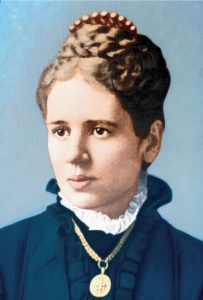If Southern Baptists have saints, there are only two and they are both women.
Each are revered for their dedication to ministry and circumspect way of living. Neither was flashy or given to being the life of the party. This does not mean they were dour but that they were consumed with the task at hand; being all things to all men that some would be saved.
None of my friends would ever be guilty of calling me a killjoy; I like having good fun like anyone else. But taking a historic spiritual icon like Annie Armstrong and monetizing her likenesses for a tongue-in-cheek moment like what happened earlier this week by the Southern Baptist Convention North American Mission Board shows how far we have come from a true reverence of her ministry.
Not even the agency’s first president, Bob Reccord, who spent a million dollars for an interactive missions exhibit in NAMB’s lobby, stooped to the level of using her heritage in such a degrading manner.

Annie Armstrong
Annie’s unfailing work resulted in the denomination’s fledgling Board of Domestic Missions — forerunner of both the SBC Home Mission Board and now NAMB — creating an offering to support the work of Southern Baptists. Financially, times were very tough in those early days and Southern Baptists were lower middle class and never were a people of means. But the Self Denial Offering connected with the man and woman in the pew and thousands of dollars were raised annually.
Today that offering continues Annie’s self-denial legacy with the name on the Annie Armstrong Easter Offering.
A look at the offering envelope, yellowed with age that I found in one of my late father-in-law’s books, is humbling to read. It says: “For each penny, nickel, dime or quarter given, punch a hole through a dot. Let an earnest prayer go with each gift.” Then it ends with the verse Annie used to justify not taking a salary as the first executive director of the new group which would become Woman’s Missionary Union: “Neither will I offer unto the Lord my God that which doth cost me nothing.”
My father-in-law, B.E. Pitts Jr., and his wife, Rachel, planted congregations throughout the Pacific Northwest as pioneer church starters in the 1950s, raising three children and dragging them along as God opened doors. He knew how hard it was to follow God’s direction on very limited funds, but he truly epitomized Annie’s spirit of self-denial.
I can’t but wonder what he would think of Annie at the wheel of an Indy Car.
The issue at hand is that the current NAMB administration is just as guilty as its first administration of ongoing financial profligacy on how it spends tithers’ funds with little regard for transparency. NAMB’s controversy du jour is that the focus of its display in the exhibit hall at Southern Baptists annual convention last week was a flashy Indy Car emblazoned with the NAMB logo and associating it with a Southern Baptist legend of sacrificial living.
The agency logo would have been a questionable enough use of funds for any agency that lives out of the offering plate. To be fair, NAMB offered an apology of sorts by tweeting out within hours that the agency “is not an official sponsor of the Indy Car Series or its affiliated entities.”
Well, that is certainly a relief and a nice step toward fiscal transparency.
What added insult to injury was a “Fueled by Annie” logo that transformed Annie from a woman living in the shadows of ministry into a contemporary and very modern-day Danica Patrick, NASCAR’s poster girl for fast cars and high living.
But you gotta give NAMB credit. Annie certainly would know how to pick her race cars, if not race horses in her day. The average Indy Car, like the one that carried her name last week, can reach top speeds of nearly 240 miles per hour, while Danica’s NASCAR choice would only top out at around 200 miles per hour.
Score one for NAMB.

Danica Patrick, driver of the #10 GoDaddy.com Chevrolet, sits in her car in the garage area during practice for the NASCAR Sprint Cup Series Subway Fresh Fit 500 at Phoenix International Raceway on March 1, 2013, in Avondale, Arizona. (Photo by Jonathan Ferrey/Getty Images)
Well, make that score two for NAMB. Both women were trailblazers of sorts, just in different arenas. Danica’s name has brought untold wealth to her sponsors, and Annie’s 18,000 handwritten letters she wrote in one year opened the eyes of Baptists to her vision of evangelism. That, in turn, opened their purses and wallets to fund an army of missionaries who continue throughout North America to this day.
To be honest, NAMB is not the first at monetizing its spiritual forbearers. Christianity crossed the line decades ago following the Jesus Movement when hucksters first monetized the name of Jesus Christ. That was when, by using the typeface created by Coca-Cola, they plastered Jesus’ name on T-shirts followed by “He’s the Real Thing” just like the Coke slogan. It became an instant hit at summer youth camps and days at the beach.
I can’t say I felt comfortable with that even then, but hey, it was a great way to share our testimony as we jumped off diving boards. We Christians certainly know how to make a buck off of the humble origins and lives of those in our history. By the way, I always wondered how they got away without lawsuits from Coca-Cola for copyright infringement or intellectual property theft.
To be honest, NAMB’s highly novel and inventive way of monetizing a historical figure’s legacy is not that far from using AI to do the same thing. The estates of deceased performing artists such as movie stars and vocalists are working overtime to prevent their likeness being used in cinema or new recordings without their permission. Financial compensation aside, the danger is fear of damage to the individual’s reputation — like Mahalia Jackson’s voice being used to sing a rap song.
Or Annie Armstrong being used on an Indy Car.
Until last week, we never envisioned that ever happening. Unfortunately, it appears there is no one to protect Annie from being monetized with a macho sports event. I think we have lost sight of telling the story of one of our most revered female missionaries and cheapening her commitment to reaching the unchurched and increasing heaven’s borders.
“Unfortunately, it appears there is no one to protect Annie from being monetized with a macho sports event.”
It’s no secret that NAMB has had a troubled and very well-documented history with leadership and transparency. And it isn’t the first time NAMB’s boys and their toys made headlines. In 2006, the agency’s Reccord enlisted a massive fire truck to tour the nation, also emblazoned with its logo, to promote a campus leadership program named Elevate. As it made appearances throughout the nation it would lower and raise its very tall ladder at stops along the way to “elevate” visibility for the conference.
Get it, “Elevate”? Cute, gotta admit.

I cannot help but feel NAMB has taken Annie Armstrong out of the category of real-life icon and moved her into a marketing icon like a real-life Danica or even a fictional Betty Crocker — just a corporate brand that sells a product. At least Betty Crocker was updated through the years with new hairstyles and clothing. I’m not sure how NAMB’s Annie would be as comfortable in a winner’s circle holding a crash helmet under one arm and being sprayed with an effervescent bottle of champagne.
Maybe we can use Billy Graham in some forthcoming advertising campaign. Maybe a co-branding effort with Nabisco with his face on a box of Graham Crackers? It would be a huge funding raising project with proceeds going to vacation Bible school efforts.
Southern Baptist agencies have become very adept at dealing with controversy. They have learned to hunker down and ride out any storm that first appears as an innocent cloud the size of a man’s hand on the horizon. That’s biblical. They know people can get their knickers in a knot but eventually they get used to the feeling and move on with their lives. Nothing changes until the next problem arises and the knot gets a little bigger and more uncomfortable. But at some point, the knot will become unbearable and someone, somewhere, will say enough is enough.
We are beginning to see the growing number of SBC messengers take to the floor of the annual meeting and become more educated in how the denomination conducts business. They are coming armed with Roberts Rules of Order so they cannot be outmaneuvered.
That momentum is slowly gaining traction in the nation’s largest evangelical group, and if I were an agency head, I would become more fearful when the next individual takes to the microphone.
The Annie Armstrong Indy Car has had its day and will quickly fad into the past. But the day is coming when messengers and their tithes will no longer settle for being taken for granted. And it will not be a pleasant sight.

Joe Westbury
Joe Westbury is a veteran Baptist journalist who previously worked for the SBC Brotherhood Commission and Home Mission Board and ultimately retired from the managing editor position at the Georgia Christian Index. He lives in Atlanta.
Related article:
Critics see NAMB race car as symbol of financial excess they still want to curb


